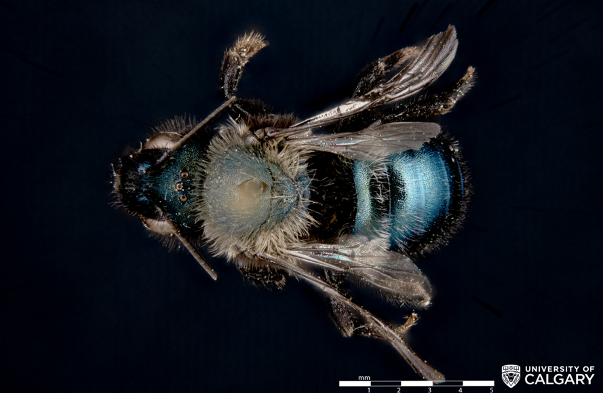June 21, 2021
Latest buzz: Interdisciplinary group wins 2021 Staff Sustainability Award

A biological science researcher, a designer, a librarian and a sustainability expert walk into a University of Calgary research lab. What could possibly happen next?
Cross-pollination between the Faculty of Science, Schulich School of Engineering, Libraries and Cultural Resources, and the Office of Sustainability produced a number of fruitful initiatives. These busy bees digitized information on more than 230 native Alberta bee species, created a biodiversity website, hosted a Pollinator Celebration event and engaged hundreds of members of the campus community to learn more about pollinator conservation.
This initiative, which aligns with the United Nation’s Sustainable Development Goals 11 - Cities and Communities and 15 - Life on Land, earned the 2021 UCalgary Sustainability Award in the Staff Sustainability category.
Dr. Mindi Summers, PhD, project lead for the Digital Bee Collection, worked with faculties, researchers and students to capture scores of high-resolution images of bees, while helping to advance the Institutional Sustainability Strategy in the process.
Innovative collection process
This interdisciplinary approach began as a way to boost accessibility to biological sciences' natural history collections for various stakeholders. Researchers and students can access the collections via an online digital library, including information on the different bee species’ scientific names, origins and taxonomy. Each bee was photographed hundreds of times from multiple angles and focuses. These images were then run through a computer program that generated a single composite image, which was later uploaded to the collection.
Researchers and undergraduate students participating in the collection process shared more than 360 public records and photographs. While this was the Taylor Family Digital Library’s first attempt at digitizing 3D objects, the digitization work is currently ongoing and expanding its offerings to include freshwater invertebrates and wasps to support student-led research.

Bees come in all shapes and colours! The Osmia Nigifrons can be found anywhere between California and Southern Alberta.
Hailey Bloom
Creativity in communication
The Digital Bee Collection team implemented a strategic communications plan to promote the Biodiversity Collections website. They surveyed stakeholders and then used the data to develop a platform that would meet the needs of students and the general public.
The site also enables biology students to share their own resources, including links to a number of outreach projects that are incorporated into coursework and course offerings.
“It is important to create these digital collections for all types of species,” says Hailey Bloom, a master of planning student who worked on the collection as a research assistant. “They are valuable for education on the importance of bees, and it’s a great way to engage people in the fun of science.”
The website and collections launch were announced at the 2019 Pollinator Celebration, hosted in partnership with the Office of Sustainability. The event attracted more than 100 registrants and consisted of public talks on pollinators, booth postings at a science library takeover event, community garden activities and media outreach.
The Pollinator Celebration took place at a globally significant time, as the worldwide drop in bee populations has raised concerns among farmers, scientists and researchers.
A plan for the future
The next step in the fight for native bees? “We’re hoping to launch a larger outreach initiative in the summer of 2022, where we can engage more students and members of the public to join us in the photography project,” says Summers. “We want to be able to better understand the diversity in the city and on campus.” There are also efforts underway to build more pollinator habitats within the community, with the team using their research and efforts to inform and educate on the significance of biodiversity.
The project continues to be promoted on Bee City Canada, social media pages and various events on campus related to UCalgary’s Bee Campus designation. Talk about a buzzing opportunity, right?
Digital Bee Collection collaborators (by faculty)
Faculty of Science and Schulich School of Engineering
Dr. Mindi Summers, PhD
Dr. Tegan Nicole Barry, BHSc’12, PhD’19
Lincoln Best
Hailey Bloom
Angela Demarse
Dr. Marjan Eggermont, BA’91, BFA’96, MFA’98, PhD’18
Dr. Paul Galpern, PhD
Holly Kerstiens, BSc’20
Dylan McLernon, MFA’18
John Swann
Dr. Jessica Madeleine Theodor, PhD
Dr. Jana Vamosi, PhD
Emily Kaing
Taylor Family Digital Library collaborators
Rob Alexander
Justin Anders
Christie Hurrell
Kathryn Ruddock, BCrt’20
Ingrid Reiche
Office of Sustainability collaborators
Amanda Mosca
Michelle Crossland
April Jang, BSc (Eng)’19
Learn more about the biodiversity collections.
The University of Calgary’s Institutional Sustainability Strategy provides a road map for continuous improvement in our pursuit of excellence and leadership in sustainability. We aim to be a Canadian post-secondary education leader in sustainability in our academic and engagement programs, administrative and operational practices and through supporting community and industry in their aims for leadership in sustainability. Learn more about UCalgary’s leadership in sustainability.
Events for Pollinator Week:
- June 22 - Online Unwind: Pollinator Speed-Friend Making + Skribbl.io
- June 23 - Bee-free and Unwind with the GSA!
- June 24 - Pollinator Week Instagram Live with Dr. Mindi Summers!





